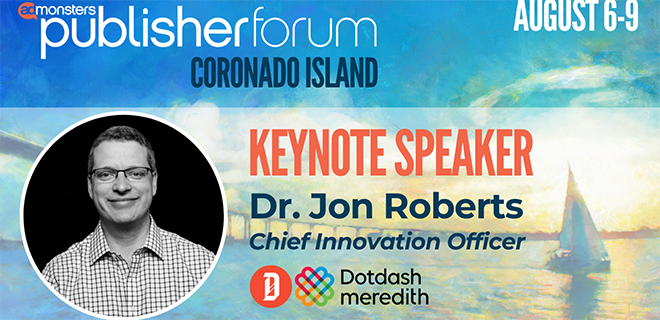
Look at the LinkedIn profile for Dr. Jon Roberts, Chief Innovation Officer, Dotdash Meredith, and you’ll find a series of accomplishments in the publishing world and beyond, ranging from theoretical physicist to mapmaker.
Before joining Dotdash Meredith, Roberts was a theoretical physicist focused on making dark matter predictions for the hadron collider at CERN and cosmic ray predictions for the AMS detector on the International Space Station. He also created the first-ever canon maps of Game of Thrones for Random House and George R. R. Martin’s “The Lands of Ice and Fire.”
Roberts says that maps empower people to make decisions using data by helping them understand a way forward.
“Mapmaking is an exercise in data-powered decision making, whether it’s in the front of a fantasy novel where I’m helping the reader make a logical choice, or in business where I hand over information in a way that other people can then make informed decisions off a common understanding and framework,” said Roberts.
Just like maps, publishers face a great deal of data and decision-making as they approach the loss of third-party cookies. During his keynote at the AdMonsters Publisher Forum, “Publishers Take the Wheel: Effective Audience Targeting in a Cookieless World,” Roberts will share how publishers can leverage intent data for ad targeting at scale.
Solving Problems From Physicist to Publisher
Roberts has been with Dotdash Meredith since 2013. As Chief Innovation Officer, Roberts oversees research, data science, and open market revenue. He was previously the President, Health & Finance, overseeing strategy for Verywell, Health, Parents, Investopedia, and The Balance, and has held various senior leadership roles, including Head of Data Science.
Before Dotdash Meredith, Roberts spent ten years as a theoretical physicist, bringing that training to his current role.
“As a physicist, you must be confident to take on problems and believe they are fixable. That belief gives me the mindset to tackle publishing challenges with an impatience to solve them,” expressed Roberts.
And right now, that challenge is solving ad targeting for publishers before the cookie gets deprecated in 2024. Roberts believes ad targeting that will work, and scale isn’t with identity targeting but with intent-based targeting.
“Trying to rebuild an identity signal across a cookieless environment is going back and fighting the fight that’s already been fought and lost. I think targeting who somebody might have been four weeks ago is much less effective than targeting who they are right now. Non-identity or intent-based targeting unlocks the full scale of a publisher,” said Roberts.
Connecting at Key Moments of Intent
In May, Dotdash Meredith launched D/Cipher, a tool that provides intent-based ad targeting without cookies. D/Cipher is based on billions of Dotdash Meredith’s proprietary consumer interactions and content signals from its 40+ brands that help 30 million people daily, providing the publisher with a unique data set.
“If we were a news publisher, we would tell the world what to care about. We are much more a service publisher, so the world tells us,” shared Roberts. “Our data gives us a heartbeat of the entire world every day.”
D/Cipher reaches users on all devices and platforms, including Apple (iOS) audiences previously unreachable by advertising cookies for the past two years, estimated at more than 50% of U.S. digital users.
So, how does D/Cipher reach the right person, at the right time, without cookies?
Roberts gives the example of targeting a parent reading articles about family vacations versus looking for a Negroni recipe. The promise of cookie targeting is knowing that the person is a parent, but intent-based targeting is knowing a person is being a parent at that moment.
“Engaging the parent with the right messaging when they’re in that mindset is powerful and requires no prior knowledge of the person. A drink recipe is when they’re specifically not being a parent, and they don’t want to see your messaging even if you got the targeting right,” explains Roberts. “We’ve removed the guesswork and only reach people when they’re ready to receive your message. It’s not surprising that we see vastly higher performance with intent targeting than with cookie targeting.”
Guaranteeing a Non-Identity-Based Approach
As part of the D/Cipher launch, the publisher announced the Dotdash Meredith Performance Guarantee, which promises performance lift versus cookie-based or other audience-based targeting for marketers using the D/Cipher tool.
Roberts shared that the guarantee’s goal is not for advertisers to shift their entire buying strategy to only intent-based targeting. Instead, Dotdash Meredith wants advertisers to simultaneously test and then scale both a cookie-based or identity-based approach and a non-cookie and non-identity-based approach in the lead-up to a cookieless environment.
“We can learn so much with a side-by-side comparison. We as an industry must get comfortable with non-identity-based targeting and measurement in the next year to 18 months so that when the cookie gets fully deprecated, you’re not trying to figure out how to do cookieless targeting in the second half of 2024 because you’re going to be doing it with little data to play with and a lot of disruption,” cautioned Roberts.
Roberts says that as America’s largest publisher, it means Dotdash Meredith is in a position to help the industry and is confident in its guarantee.
“We guarantee you that your intent-based campaign will outperform the cookie-based campaign. We know it works because we’ve been doing this a long time, and that takes the risk off the table,” said Roberts.